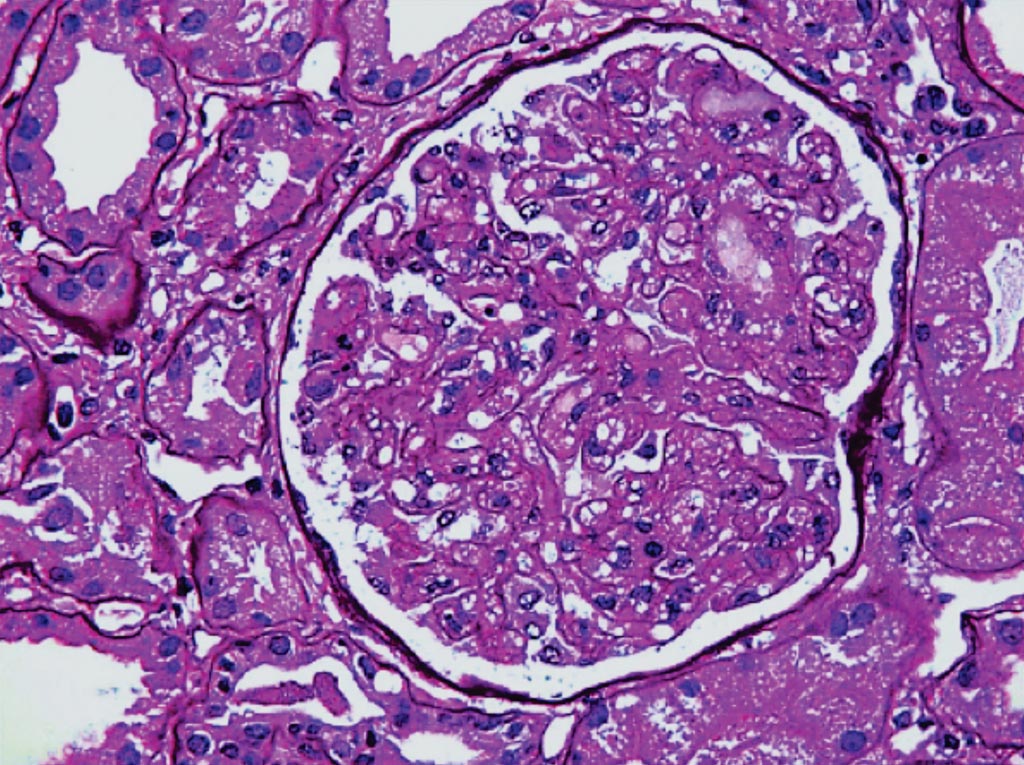New Test Rapidly Diagnoses Preeclampsia
By LabMedica International staff writers
Posted on 09 Aug 2017
Preeclampsia can lead to kidney damage in many affected women and the only therapy currently available is delivery of the baby, but this often means that infants are born prematurely and may have medical problems related to their early delivery.Posted on 09 Aug 2017
More effective treatment strategies will depend on methods that would diagnose women with preeclampsia in a timely manner and a better understanding of preeclampsia’s underlying mechanisms. Recent studies indicate that preeclampsia is linked with the abnormal presence in the urine of podocytes; however, available tests that can identify podocytes are expensive and time-consuming.

Image: A histopathology of a glomerulus from a patient with preeclampsia revealing a pronounced bubbly appearance in the consolidated areas, caused by swollen endothelial cells and podocytes (Photo courtesy of Dr. Vivette D’Agati, MD).
An international team of scientists collaborating with those at the Mayo Clinic, (Rochester, MN, USA) recruited at delivery a study population included 49 preeclamptic and 42 normotensive pregnant women. Plasma measurements included cell free fetal hemoglobin (HbF) concentrations and concentrations of the endogenous chelators haptoglobin, hemopexin, and α1- microglobulin. They assessed concentrations of urinary extracellular vesicles (EVs) containing immunologically detectable podocyte-specific proteins by digital flow cytometry and measured nephrinuria by an enzyme-linked immunosorbent assay (ELISA).
When the team compared the urine from women with normotensive pregnancies with urine from women with preeclamptic pregnancies, the latter contained a high ratio of podocin-positive to nephrin-positive urinary EVs (podocin+ EVs-to-nephrin+ EVs ratio) and increased nephrinuria, both of which correlated with proteinuria. Plasma levels of hemopexin, which were decreased in women with preeclampsia, negatively correlated with proteinuria, urinary podocin+ EVs-to-nephrin+ EVs ratio, and nephrinuria. They also found that fetal haemoglobin, which is normally present in pregnant women’s blood in small amounts, is present in higher amounts in pre-eclamptic women’s blood.
The authors concluded that their findings provide evidence that urinary EVs are reflective of preeclampsia-related altered podocyte protein expression. Furthermore, renal injury in preeclampsia associated with an elevated urinary podocin+ EVs-to-nephrin+ EVs ratio and may be mediated by prolonged exposure to cell free HbF.
Vesna D. Garovic, MD, a professor of Nephrology and Hypertension and the senior author of the study, said, “This increased amount of fetal haemoglobin in preeclampsia may be causing the release of podocyte fragments in the urine. We hope that this information will result in improved diagnostic procedures in women with pre-eclampsia; however, additional studies in larger numbers of patients and across different types of preeclampsia are needed.” The study was published on July 20, 2017, in the journal Clinical Journal of the American Society of Nephrology.
Related Links:
Mayo Clinic












